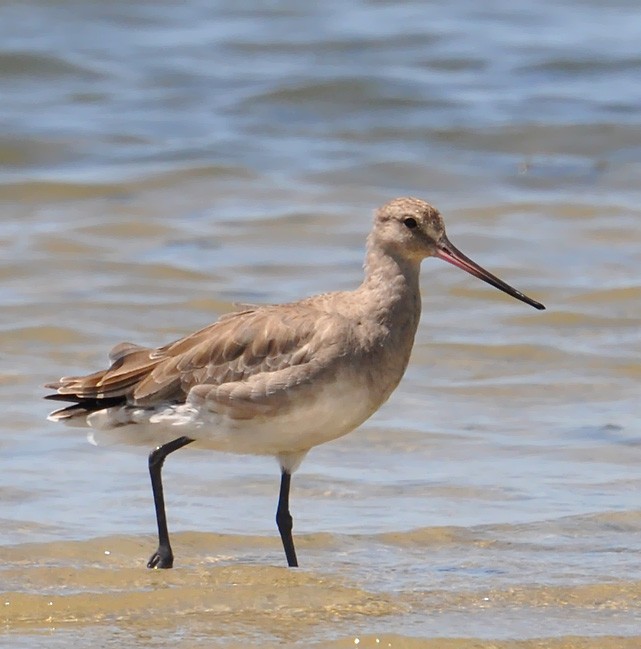Hudsonian Godwit
A species of Godwits Scientific name : Limosa haemastica Genus : Godwits
Hudsonian Godwit, A species of Godwits
Botanical name: Limosa haemastica
Genus: Godwits
 Photo By Cláudio Dias Timm , used under CC-BY-SA-2.0 /Cropped and compressed from original
Photo By Cláudio Dias Timm , used under CC-BY-SA-2.0 /Cropped and compressed from original Description
Adults have long dark legs and a long pink bill with a slight upward curve and dark at the tip. The upper parts are mottled brown and the underparts are chestnut. The tail is black and the rump is white. They show black wing linings in flight. The legs and feet are bluish-grey. 
Size
36-41 cm (14-16 in)
Nest Placement
Ground
Clutch Size
2 - 4 eggs
Feeding Habits
Hudsonian Godwit primarily consume invertebrates, employing a tactile hunting method of probing soil and mud with their bills to detect prey—beetles, flies, mosquitoes, grasshoppers, snails, earthworms, marine worms, bivalves, small crustaceans, and fiddler crabs. They also pick food by sight from surfaces or vegetation, and during migration, they consume plant tubers, berries, and seeds.
Habitat
Hudsonian Godwit predominantly inhabits wetlands, including marshes, prairie pools, and mudflats, favoring the transitional zones between boreal forests and wet tundra meadows during breeding season. These areas are characterized by muskeg bogs with acidic soils supporting mosses, sedges, and dwarf shrubs. Throughout migration, hudsonian Godwit stops at diverse open wetlands, such as flooded agricultural fields and coastal mudflats, adapting to altitudes up to 12,140 feet in the Andes. Their wintering grounds span tidal flats in southern South America, locating also in freshwater and brackish habitats.
Nest Behavior
Hudsonian Godwit's nest is selected by the female from scrapes made by the male in the territory. Egg-laying and nest-building occur on these chosen sites, with shared parental care for the eggs and offspring after hatching.
Nest Characteristics
The nest of hudsonian Godwit is a scrape or depression on a dry hummock in a sedge marsh, often near dwarf birch or shrubs. Measuring around 5.6 inches wide and 1.7 inches tall, it’s lined with twigs, leaves, sedges, bog rosemary, spruce needles, grasses, mosses, and lichens.
Dite type
Aquatic invertebrate eater
Migration Overview
They migrate to South America and the Caribbean. These birds gather at James Bay before fall migration. In good weather, many birds make the trip south without stopping. They are vagrants to Europe, Australia, and South Africa. They can perhaps be most easily seen in migration on the east coast of North America where they can be plentiful in migration in late July through early August. 
General Info
Feeding Habits
Bird food type
Sounds
Call
Recording location: Chile
Behavior
Hudsonian Godwit exhibit remarkable behaviors, starting with their courtship displays, where males perform spiraling flights and wing-beating while singing to attract females. These aerial acrobatics are paired with distinctive dives and wing-fanning perched atop trees or hummocks. In their Arctic tundra habitat, they establish territories and exhibit aggresive territorial displays. Unusually, they may share airspace with Short-billed Dowitchers during mating rituals. Hudsonian Godwit form monogamous pairs, sometimes remaining together across seasons and returning to familiar territories, where both parents fiercely protect their nest and nurture their young—a behavior not typical of all shorebirds. Post-nesting, they gather in flocks, with adults migrating before juveniles. During migration and in their wintering grounds, they behave sociably, often engaging in minor disputes, but unlike some shorebirds, they don't defend winter feeding territories.
Species Status
Their numbers were reduced by hunting at the end of the 19th century. 
Scientific Classification
Phylum
Chordates Class
Birds Order
Shorebirds Family
Sandpipers Genus
Godwits Species
Hudsonian Godwit